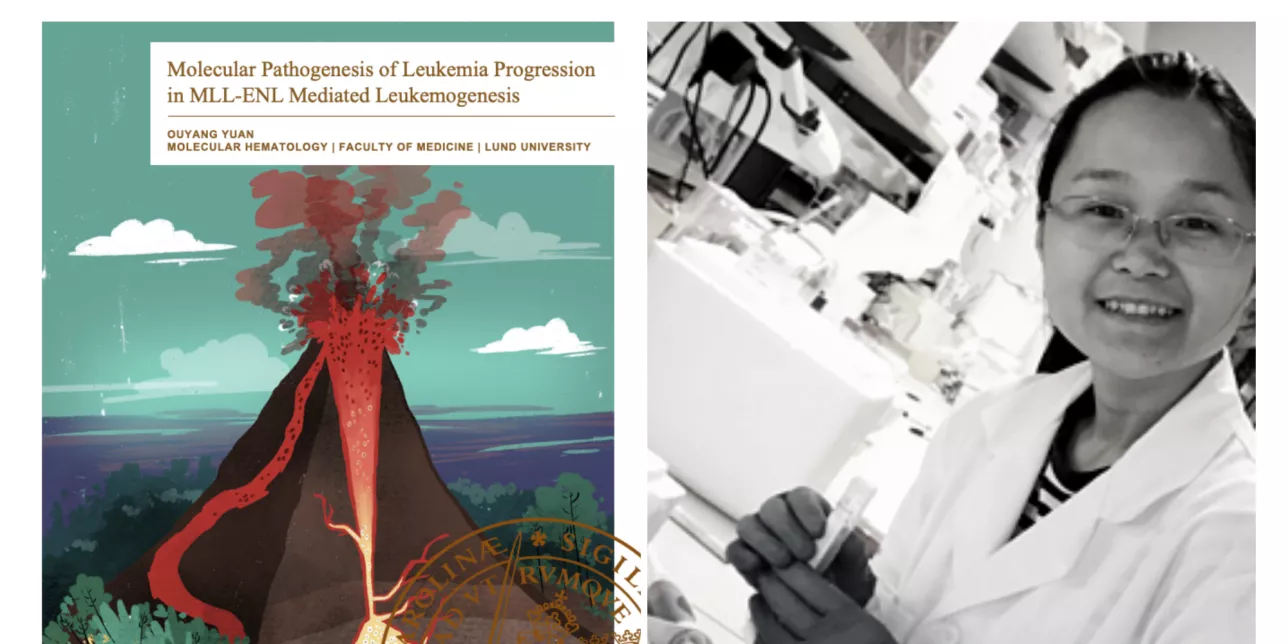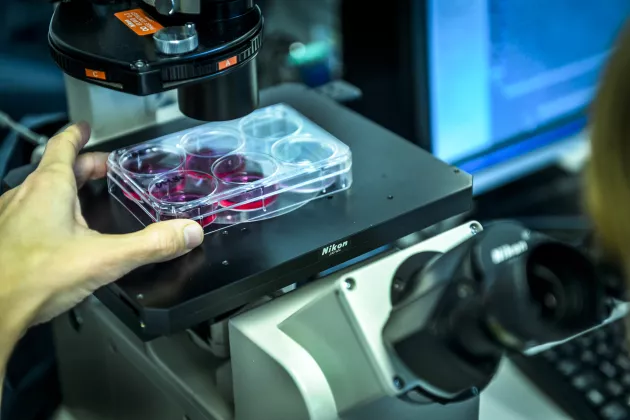What have your Ph.D. studies focused on?
“My Ph.D. has focused on the molecular pathogenesis of leukemia progression. Acute myeloid leukemia (AML) is a type of blood cancer that affects the development and production of normal blood cells. AML is caused by genetic changes to our DNA. Normally, more than one genetic change is required for AML to develop, and this usually happens in a stepwise process. The changes that occur first, primary changes, lead to a so-called pre-leukemic state (pre-AML). Additional, secondary changes, then lead to full-blown AML.
Research has shown that the first changes occur several years before AML diagnosis making it impossible to study the early process in humans. By using a mouse model established by the Bryder lab, we were able to study which combination of gene changes (mutations) cause AML and whether the order in which they occur is of importance for the development of the disease.
In my first article, we studied what happens from when the initial gene change occurs (in our case introduction of the MLL-ENL gene) until disease development. We discovered that in 65.6% of cases, the moesin (Msn) gene had mutated. Mutations of this gene had not yet been found in AML patients but patients with other cancer types, suggesting that this gene is involved in several different cancers.
In Article 2, I was involved in as collaborator, we investigated the influence of a fetal-specific gene (Lin28b) on AML development, also using our mouse model. Our findings suggest that fetal-specific genes such as Lin28b might inhibit cancer development and possibly constitute one new possible therapeutic target for the treatment of MYB-dependent cancers, including MLL-ENL driven AML.
In Article 3, I was again involved in as collaborator. Here we studied a previously established expansion approach that can be used to increase the number of available blood stem cells by growing them in incubators outside of the body. Here we found that this cultivation system facilitates basic and clinical blood cell research as we managed to increase the number of blood stem cells ~300 times over three weeks, although they account for only 0.1% of all cells grown in the culture.
Overall, our goal with this project was to better understand how leukemia develops in order to identify targets that can be used to interrupt or prevent AML disease progression and possibly treat or cure the disease in the future,” summarized Ouyang.
Can you tell us more about the cover of your thesis?
“For my thesis cover, I designed it and asked a professional illustrator to help me make it more like art in a way. For the design, I got the idea to create the process of an erupting volcano as the representation of the development of acute myeloid leukemia.
For example, normal hematopoiesis originates from hematopoietic stem cells. But leukemia develops when these cells acquire some mutation or gene anomaly. So, here we have drawn a root showing how hematopoietic stem cells are producing normal hematopoiesis which is represented by this nice green plant.
When disease development begins, it happens through a multi-step process which is represented here using color blocking along the outside of the volcano. During this step clonal evolution takes place where some clones acquire a gene mutation at varying time points and then compete out the other clones, expanding until they occupy the entire bone marrow, which in the end leads to the formation of the disease. So, the lava vein represents the process the leukemic cells take to inhibit normal hematopoiesis.
We also added some additional offshoots, which indicate that some clones may only undergo one genetic event which may be more aggressive than the normal cells, but do not lead to the development of the disease in the end. The faraway scenery in the background indicates that there is still long way to go, and more studies are needed to answer the questions in the field,” described Ouyang.
How did you end up doing a Ph.D. at Lund Stem Cell Center?
“Before joining the Center, I was a medical student. I studied in China and my master’s degree focused on hematology and hematopoietic malignancies. Now, I have been in Sweden for some time, 6 1/2 years in total.
When I decided I wanted to come to Lund University and work in hematology, I looked at the different departments and found the Department of Molecular Hematology. After this, I explored the topics of each group within the department and found David Bryder. I thought that his group was researching very interesting topics, covering both leukemic and normal hematopoiesis. I thought, that by doing research or a Ph.D. in his lab, I would be able to gain knowledge and training in both areas. So, I reached out to him, and that is what happened. Even though I focused more on the leukemic project, I’ve also been able to learn a lot about normal hematopoiesis through our lab meetings and journal clubs,” noted Ouyang.
What have you found the most enjoyable during your Ph.D. studies?
“I would say that I’ve enjoyed the overall environment and how easy it is to interact and communicate with many people around our team and on our floor. We have a seminar each week where people share and present their ongoing projects and data. This always sparks a lot of discussion and communication and I like that we can be very open with our colleagues. It is a very open environment and is very accessible for you to talk, discuss, and brainstorm with someone. Within our research group and during our lab meetings, we also have many discussions and a Journal Club, all of which I enjoy.
Beyond our floor, there is also the Stem Cell Center, which is a very international environment with people from different backgrounds and cultures. I have enjoyed that we can come together through the many activities the Center hosts. For example, the Stem Cell Seminars where guest lecturers are invited from outside to give a talk. This has been great to have, especially during the pandemic, when we could not go to conferences. It is excellent that we still had the chance to listen to and get to know what top-notch scientists outside Lund University and the Center are doing. This I have enjoyed,” highlighted Ouyang.
What has been the most challenging aspect?
“For me, there have been three main challenges. The first relates to my scientific background before starting my Ph.D. Previously, I was doing more clinical research using clinical samples. When I started here to do more experimental research, it was almost a completely new field. It was much more on the molecular side, using mouse models and I needed to start to design my experiments. This was very challenging for me at the beginning because I did not have that in my knowledge toolbox to start with.
The second challenge happened in the later stages of my Ph.D., after my half-time. I realized I needed to have a broader overview of the whole field instead of focusing only on my project and this specific gene, the specific mutation, that we were looking at. Lastly, the culture here is very different from China. In the beginning, I felt that it was a bit challenging to communicate with people at work but also in my personal life. I think later though, as I settled in more here, everything worked out quite well,” stated Ouyang.
What are your plans following your Ph.D. defense?
“The plan is to go back to the hospital in Shanghai and continue my internship rotation. At the same time, I will also continue my research in the lab as part of the clinical postdoctoral program within the Department of Oncology. I think I will continue with my research interests surrounding leukemia, but I am also open to exploring other types of malignancies,” said Ouyang.
Any tips or advice for future Ph.D. students?
“First, before one starts a Ph.D. it is good to know what you want to do, what you are interested in. Then when you have first started it is good to be open to new experiences, different fields, and different topics. One should not limit oneself to a very specific field at the beginning of the Ph.D. After some time, though, it is good to be more selective or focused on a specific project and to find a theme for the Ph.D. thesis. We have four years to do our Ph.D., and when you think about it, four years seems quite long, but in reality, it goes much faster. After you find a specific project that you want to focus on, it will still take a very long time before you have a complete thesis. So, it is good to be open in the beginning and focused toward the end.
My last tip is to communicate and discuss and ask questions, especially if you feel that you do not understand something. It is better to talk to someone rather than trying to figure it out on your own,” concluded Ouyang.



